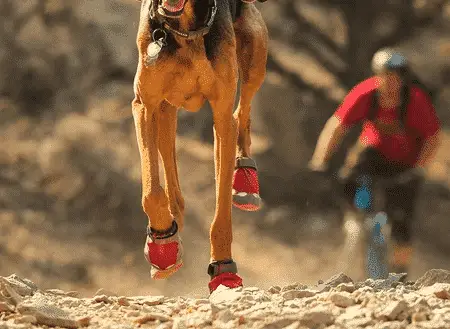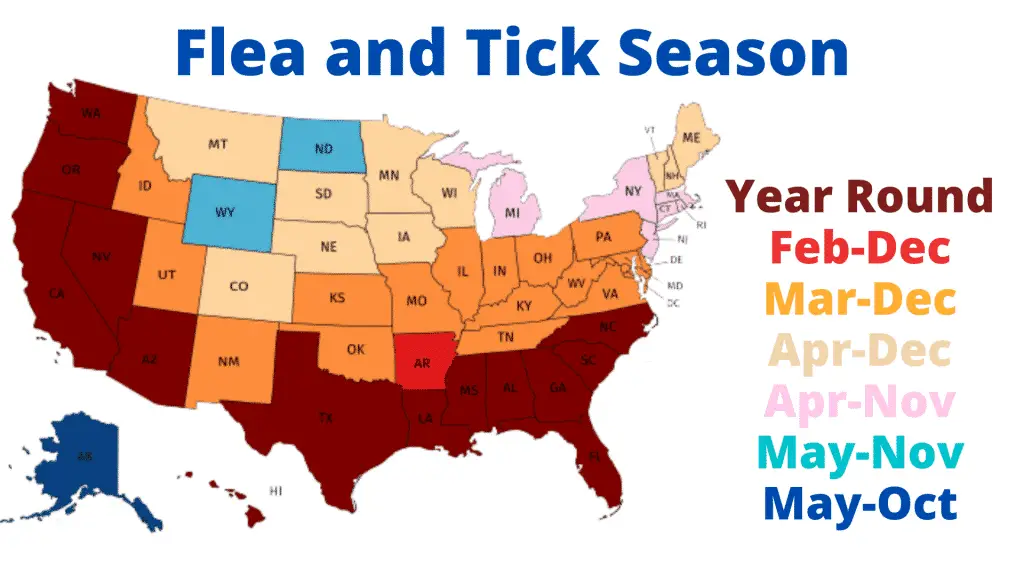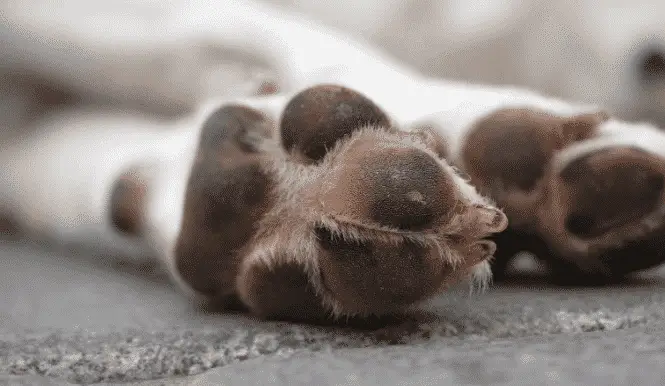Dogs make the perfect hiking companions! They’re overly enthusiastic, never complain and keep up with even the most experienced hikers. You probably don’t even realize how much your dog can endure on the trail.
Unfortunately, that enthusiasm and drive can lead your dog down a dangerous path. Blind devotion is a powerful thing. Your dog will just keep on following you past the point of physical exhaustion. If you’re not careful this could lead to permanent injury.
If your dog keeps licking their paws after a long hike, warning bells should start going off in your head. Something is causing this change of behavior and you need to figure out the problem.
Table Of Contents
Why Do Dogs Lick Their Paws After a Hike?
Watching your dog obsessively lick and chew at their paws can be somewhat unnerving. You can see the frustration in their eyes as they chew away at their already tender paws. So why would a dog excessively lick their paws after a hike?
There are three main reasons why your dog might lick their paws after a hike. Their feet could be itchy, but they’re usually just sore and painful after a long hike. Boredom and anxiety also come into play, but those behaviors would show up at home as well.
Don’t worry! If your dog won’t stop licking their paws they’re probably just a little tender. Check for ticks/fleas, torn pads, cracked nails, dry/cracking paws and other obvious signs of injury.
If there’s no obvious signs of injury and your dog isn’t limping they’ll be back to normal in no time. Here’s how I protect my dogs paws on hikes. With proper training, paw moisturizers and hiking booties you can really cut down on pain.
1) Pain and Swelling
Think about how your feet feel after a long day on the trail. What’s the first thing you do after setting up camp? Probably take off your shoes/socks and give your feet a much deserved break.
It should seem obvious why your dog keeps licking their paws. Their feet are sore/swollen, probably dry and scraped up from the trail. All those tiny cuts and tears in the pads of their feet just start to hurt after a while.
Don’t Ignore Licking
Does your dog constantly lick their paws at home? Then they’re probably just itchy, bored or anxious. If this is a completely new compulsion then they’re probably in pain.
After a long day on the trail your paws will definitely be a little sore(just like your feet). Do people just wake up and randomly decide to run a marathon? No it takes a few months to slowly get into shape.
You can’t just expect your dog to hop off the couch and be ready for a long hike. So how far can a dog hike? After a lot of training a healthy dog should be able to handle a 10-20 mile hike. It all depends on the age of your dog and overall fitness level.
Consider Purchasing Dog Hiking Boots

Check the bottoms of your dogs paws the next time you go on a hike. After a long 6+ hour hike the pads on your dog’s paws will really start to get beat up. They start to crack, peel and might even bleed.
Imagine trying to walk on gravel and cement without wearing tennis shoes. Your feet would be blistered and bloody in less than 1 hour. Even though your pup is used to walking barefoot it still takes a toll on their paws.
If you plan on doing a lot of hiking and backpacking you should really consider purchasing a pair of dog hiking boots. You don’t have to worry about those annoying overuse injuries and the rubber soles increase traction on slippery surfaces.
When you end up carrying a heave dog the last couple of miles, you’ll be kicking yourself for not buying dog booties. I really like the Ruffwear Lineup of dog boots. They work really well and basically last forever.
Regardless of the dog booties you choose, do yourself a favor and spend the extra money on the Ruffwear boot liners. They keep the boots from falling off and make it so much easier to put them on an uncooperative dog. Plus they add a little bit of extra padding.
Is Your Dog Limping?
Dogs are pretty tough and they don’t like to show weakness. They won’t just start limping for no reason. A limping dog means that something is definitely wrong.
It’s hard to self diagnose the problem without taking your dog to the vet. Check your dogs paws, pads and nails for signs of obvious injury. If you can’t see anything the problem could be deeper. Watch the video below for a veterinarian demonstration showing how to check out a limping dog.
2) Dry, Itchy and Cracked Paws
Ever look at an old dogs paws? After years of callous buildup their paws start to look dry and cracked up. All those tiny little cracks and wrinkles collect dirt, fungus and moisture causing dry itchy paws.
Use Paw Moisturizers to Treat Dry Itchy Paws
You need to toughen up your dog’s feet before heading out for a hike. Start off with short 1-2 hour hikes on easy terrain and slowly build up mileage.
After a few weeks of taking regular short walks, you can build up to longer day hikes and overnights. Dogs didn’t become man’s best friend by random chance. They quickly adapt to new environments and no how to work.
If your dog has dry cracked paws you should definitely use some kind of paw moisturizer. I’ve had a lot of luck with Musher’s Secret Paw Wax. The stuff is seriously cheap and works surprisingly well.
Start off by applying it every day then switch to a once-weekly and as-needed basis. There will be a night and day difference after 2-3 weeks of treatment.
3) Watch For Fungus and Yeast Infection
Dogs can get fungus and yeast infections just like humans. Anybody that’s ever had a case of athletes foot knows how annoying it can be. You end up with itchy, red, nasty looking feet.
If you suspect a fungus or yeast infection your best bet is to head down to your local vet. They will probably test for allergies and prescribe an anti-fungal medication. Don’t treat dogs with human anti-fungal creams that may not be safe for your dog to eat.
If you can’t afford to take the dog to the vet for prescription treatment you might want to try OTC Antiseptic and Antifungal Sprays. They might not be as fast-acting, but they will treat most skin infections.
4) Fleas and Ticks

Although your dog can get fleas and ticks all year round there’s a far greater risk during the warmer months. You need to take special precautions when hiking throughout the flea and tick season. Figure out your states flea/tick season by referring to the chart above.
Make sure you remember to apply some kind of flea and tick treatment. Personally I like the oil that you rub down your dogs back, but you can also use flea collars. You might also want to spray your dog with a flea and tick spray before heading out (this stuff really works).
Make sure you check your dog for fleas and ticks throughout the day and at the end of every hike. Fleas and ticks can cause extreme itchiness and good luck getting them out of your house.
5) Allergies
You never know what’s going to cause allergies in a dog. Years ago one of my boxers kept getting an itchy rash on her stomach and paws. It would come and go randomly and we couldn’t figure out what was causing it.
After months of constant rash, licking and chewing we finally realized what the problem was. She was allergic to that weird spray on grass seed that the illuminating company sprayed in the ditch.
You never know what’s going to cause allergies in a dog. It could be a change in food, mold, grass, weeds or even pollen. If you suspect an allergy try to pinpoint the source.
6) Cold Weather Deicing Salts and Chemicals
If your dog only licks their paws during the winter it’s probably due to the salt and chemical treatments used to prevent ice. The salt used to melt ice on roads and sidewalks can cause chemical burns on a dogs feet.
You’ll want to make sure that you wash off the dogs feet and might want to consider using pet boots when they go outside. If your dog can’t get used to the pet boots start applying Musher’s Secret Paw Wax. It will both heal your dogs paws and add a protective layer to the pads of their feet.
Also check for little balls of ice that can get lodged between a dogs toes. If your dog is really harry the fur can freeze between his toes which can be really painful. To prevent ice balls from forming you can once again use Musher’s Wax or Rub a little crisco on the foot pads.
7) Foreign Objects
When was the last time you had a splinter stuck in the bottom of your foot? As the day goes on you feel a sharp stabbing pain that just keeps getting worse. Before you know it your shoes are off and you just start frantically digging.
This is exactly how your dog feels when it gets a thorn or rock stuck in his paw. They just keep digging and licking hoping the pain will go away.
Do your dog a favor and check his paws and the gap between his toes for rocks, twigs, thorns, etc. You might just find what’s causing all the stress.




